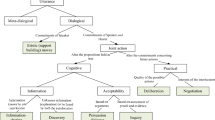Abstract
This paper investigates the role of lexical ambiguity in the processing and recognition of multimodal advertisements. First, we combined 28 Russian advertising posters: 14 ads with an ambiguous headline that leads to the conflict between text and pictural parts of a poster and 14 explicit ads of the same structure and advertising product as their ambiguous pairs. In Exp.1, 104 Russian participants looked at the stimuli and rated the stimuli by 6 parameters: how eye-catching, original, impelling to buy the advertised product, understandable, evoking positive emotions and matching the product the posters are. We used scales from 1 to 5. The experiment was conducted via Google Forms. 3–4 weeks later, in Exp. 2, the same participants were invited to recognize verbal and non-verbal “halves” of the posters from Exp. 1. The results of the scaling experiment showed that ambiguous advertising posters were ranked significantly higher than unambiguous ads by four of six parameters. Furthermore, ambiguous posters were rated as slightly more understandable than unambiguous posters, despite the expectation that word-play would complicate the understanding of the ambiguous posters. In the recognition task, we revealed that both verbal and non-verbal components of a poster are recognized better if they were a part of an ambiguous poster. These findings are discussed in relation to the multimodal text literature, and research perspectives are provided to explore ambiguous text processing empirically.
Access this chapter
Tax calculation will be finalised at checkout
Purchases are for personal use only
Similar content being viewed by others
Notes
- 1.
One can find all the advertising posters used in the experiment at https://drive.google.com/drive/folders/1N4OpYaqKCpu6pueTbbXe8pFRWJHAv6V2?usp=sharing (Google Folder).
References
Paivio A (2006) Dual coding theory and education. In: Neuman S (ed) Pathways to literacy achievement for high poverty children. The University of Michigan School of Education, pp 1–19
Kress G, van Leeuwen T (1996) Reading images: the grammar of visual design. Routledge, London
Kergoat M, Meyer T, Merot A (2017) Picture-based persuasion in advertising: the impact of attractive pictures on verbal ad’s content. J Consum Mark 34(7):624–635. https://doi.org/10.1108/JCM-01-2016-1691
Obermiller C, Sawyer AG (2011) The effects of advertisement picture likeability on information search and brand choice. Mark Lett 22(2):101–113. https://doi.org/10.1007/s11002-010-9118-x
Wedel M, Pieters R (2000) Eyes fixations on advertisements and memory for brands: a model and findings. Mark Sci 19(4):297–312. https://doi.org/10.1287/mksc.19.4.297.11794
Radach R, Lemmer S, Vorstius C, Heller D, Radach K (2003) Eye movements in the processing of print advertisements. In: Hyönä J, Radach R, Heiner D (eds) The mind’s eye: cognitive and applied aspects of eye movement research. Amsterdam, The Netherlands, Elsevier, pp 609–632. https://doi.org/10.1016/B978-044451020-4/50032-3
Rayner K, Rotello CM, Stewart AJ, Keir J, Duffy SA (2001) Integrating text and pictorial information: eye movements when looking at print advertisements. J Exp Psychol Appl 7(3):219–226. https://doi.org/10.1037/1076-898X.7.3.219
Shepard RN (1967) Recognition memory for words, sentences, and pictures. J Verbal Learn Verbal Behav 6(1):156–163. https://doi.org/10.1016/S0022-5371(67)80067-7
Al-Subhi AS (2022) Metadiscourse in online advertising: exploring linguistic and visual metadiscourse in social media advertisements. J Pragmat 187:24–40. https://doi.org/10.1016/j.pragma.2021.10.027
Higgins E, Leinenger M, Rayner K (2014) Eye movements when viewing advertisements. Front Psychol 5(902):210, 1–15. https://doi.org/10.3389/fpsyg.2014.00210
Brown S (2006) Ambi-brand culture: on a wing and a swear with Ryanair. In: Schroeder JE, Salzer-Morling M (eds) Brand culture. Routledge, London, pp 50–66
Mayer RE (2009) Multimedia learning, 2nd edn. Cambridge University Press. https://doi.org/10.1017/CBO9780511811678
Beymer D, Orton P, Russell D (2007) An eye tracking study of how pictures influence online reading. In: Baranauskas C et al (eds) Interact 2007, LNCS 4663, Part II. Springer, pp 456–460. https://doi.org/10.1007/978-3-540-74800-7_41
Pirogova YK (2000) Speech influence and game techniques in advertising. In: Pirogova YK, Baranov AN, Parshin PB (eds) Advertising text. Semiotics and linguistics. Grebennikov Publishing House, Moscow, pp 167–190. (in Russian)
Ortlieb SA, Kügel WA, Carbon CC (2020) Fechner (1866): The aesthetic association principle—a commented translation. i-Perception 11(3):1–20. https://doi.org/10.1177/2041669520920309
Frumkina RM, Vasilevich AP (1971) Obtaining estimates of the probabilities of words by psychometric methods. In: Frumkina RM (ed) Probabilistic forecasting in speech. Nauka, Moscow, pp 7–28. (in Russian)
Mohanty P, Ratneshwar S (2015) Did you get it? Factors influencing subjective comprehension of visual metaphors in advertising. J Advert 44:232–242. https://doi.org/10.1080/00913367.2014.967424
Alonso Dos Santos M, Calabuig F, Hervàs J (2019) Influence of perceived and effective congruence on recall and purchase intention in sponsored printed sports advertising: an eye-tracking application. Int J Sports Mark Sponsorship 20(4):617–633. https://doi.org/10.1108/IJSMS-10-2018-0099
Singh SN, Rothschild ML, Churchill GA Jr (1988) Recognition versus recall as measures of television commercial forgetting. J Mark Res 25:72–80
Thorson E, Rothschild ML (1983) Recognition and recall of commercials: prediction from a text comprehension analysis of commercial scripts. In: Percy L, Woodside AG (eds) Advertising and consumer psychology. Lexington Books, Lexington, MA
Acknowledgements
The study was supported by the research grant no. 21-18-00429 “Cognitive mechanisms of multimodal information processing: text type & type of recipient” from Russian Science Foundation.
Author information
Authors and Affiliations
Corresponding author
Editor information
Editors and Affiliations
Rights and permissions
Copyright information
© 2023 The Author(s), under exclusive license to Springer Nature Singapore Pte Ltd.
About this paper
Cite this paper
Konovalova, A., Petrova, T. (2023). Image and Text in Ambiguous Advertising Posters. In: Yang, XS., Sherratt, S., Dey, N., Joshi, A. (eds) Proceedings of Seventh International Congress on Information and Communication Technology. Lecture Notes in Networks and Systems, vol 465. Springer, Singapore. https://doi.org/10.1007/978-981-19-2397-5_11
Download citation
DOI: https://doi.org/10.1007/978-981-19-2397-5_11
Published:
Publisher Name: Springer, Singapore
Print ISBN: 978-981-19-2396-8
Online ISBN: 978-981-19-2397-5
eBook Packages: EngineeringEngineering (R0)




